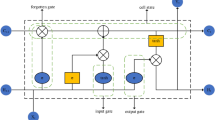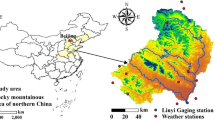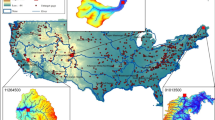Abstract
The exploitation of hydropower provides cleaner, more sustainable, and cheaper energy than fossil fuels. Therefore, hydropower offers prospects to meet the sustainable development goals of the United Nations. These benefits motivate this study to develop different models for efficient runoff prediction utilizing multivariate hydro-meteorological data. The techniques employed for this purpose include correlation analysis, time series decomposition, sample entropy (SE), and sequence2sequence (S2S) algorithm with spatio-temporal attention (STAtt). The decomposition techniques include improved complete ensemble empirical mode decomposition with additive noise (ICEEMDAN) and the maximal overlap discrete wavelet transform (MODWT). The ICEEMDAN-STAtt-S2S model reveals the best prediction results over the counterpart hybrid and standalone models in terms of statistical metrics and comparison plots. The ICEEMDAN-STAtt-S2S model decreases RMSE by 19.348 m3/s, 14.35 m3/s, 13.937 m3/s, 13.681 m3/s, 11.988 m3/s, 9.066 m3/s, 7.7 m3/s, 7.129 m3/s, 5.511 m3/s, 4.071 m3/s, 2.011 m3/s for SVR MLR, MLP, XGBoost, LSTM, S2S, SAtt-S2S, TAtt-S2S, STAtt-S2S, MODWT-STAtt-S2S, and ICEEMDAN-SE-STAtt-S2S models, respectively. In terms of NSE, the ICEEMDAN-STAtt-S2S model is 10%, 7.4%, 7.3%, 7.1%, 5.9%, 4.5%, 3.7%, 3.4%, 2.6%, 1.9%, and 0.9% more efficient compared to SVR MLR, MLP, XGBoost, LSTM, S2S, SAtt-S2S, TAtt-S2S, STAtt-S2S, MODWT-STAtt-S2S, and ICEEMDAN-SE-STAtt-S2S models, respectively. The surpassed prediction outcomes substantiate the merger of ICEEMDAN and S2S utilizing STAtt for runoff prediction. Moreover, ICEEMDAN-STAtt-S2S offers the potential for reliable prediction of similar applications, including renewable energy, environment monitoring, and energy resources management.








Similar content being viewed by others
Data Availability
The hydrological data used in this study are taken from the Surface Water Hydrology Project, WAPDA, Pakistan, whereas the meteorological data have been obtained from the Pakistan Meteorological Department. Data will also be made available on request.
References
Abdel-Nasser M, Mahmoud K, Lehtonen M (2021) HIFA: promising heterogeneous solar irradiance forecasting Approach based on Kernel Mapping. IEEE Access 9:144906–144915
Adikari KE, Shrestha S, Ratnayake DT, Budhathoki A, Mohanasundaram S, Dailey M (2021) Evaluation of artificial intelligence models for flood and drought forecasting in arid and tropical regions. Environ Model Softw 144:105136
Ahmed AAM, Jui SJJ, Chowdhury MAI, Ahmed O, Sutradha A (2023) The development of dissolved oxygen forecast model using hybrid machine learning algorithm with hydro-meteorological variables. Environ Sci Pollut Res 30(3):7851–7873
Apaydin H, Sibtain M (2021) A multivariate streamflow forecasting model by integrating improved complete ensemble empirical mode decomposition with additive noise, sample entropy, Gini index and sequence-to-sequence approaches. J Hydrol 603:126831
Ashraf E, Kabeel AE, Elmashad Y, Ward SA, Shaban WM (2023) Predicting solar distiller productivity using an AI Approach: modified genetic algorithm with Multi-layer Perceptron. Sol Energy 263:111964
Balti H, Ben Abbes A, Farah IR (2024) A Bi-GRU-based encoder–decoder framework for multivariate time series forecasting. Soft Computing
Bilal M, Ali MK, Qazi U, Hussain S, Jahanzaib M, Wasim A (2022) A multifaceted evaluation of hybrid energy policies: the case of sustainable alternatives in special economic zones of the China Pakistan Economic Corridor (CPEC). Sustain Energy Technol Assess 52:101958
Colominas MA, Schlotthauer G, Torres ME (2014) Improved complete ensemble EMD: a suitable tool for biomedical signal processing. Biomed Signal Process Control 14:19–29
Dai Z, Zhang M, Nedjah N, Xu D, Ye F (2023) A Hydrological Data Prediction Model based on LSTM with attention mechanism. 15(4):670
Debnath J, Debbarma J, Debnath A, Meraj G, Chand K, Singh SK, Kanga S, Kumar P, Sahariah D, Saikia A (2024) Flood susceptibility assessment of the Agartala Urban Watershed, India, using machine learning algorithm. Environ Monit Assess 196(2):110
Ditthakit P, Pinthong S, Salaeh N, Weekaew J, Thanh Tran T, Bao Pham Q (2023) Comparative study of machine learning methods and GR2M model for monthly runoff prediction. Ain Shams Eng J 14(4):101941
Emadi A, Sobhani R, Ahmadi H, Boroomandnia A, Zamanzad-Ghavidel S, Azamathulla HM (2022) Multivariate modeling of agricultural river water abstraction via novel integrated-wavelet methods in various climatic conditions. Environ Dev Sustain 24(4):4845–4871
Fijani E, Khosravi K (2023) Hybrid iterative and Tree-Based Machine Learning Algorithms for Lake Water Level forecasting. Water Resour Manage 37(14):5431–5457
He Y, Tsang KF (2021) Universities power energy management: a novel hybrid model based on iCEEMDAN and bayesian optimized LSTM. Energy Rep 7:6473–6488
Hui G, Gu F, Gan J, Saber E, Liu L (2023) An Integrated Approach to Reservoir characterization for evaluating Shale Productivity of Duvernary Shale: insights from multiple Linear regression. 16(4):1639
Jiang L, Tao Z, Zhu J, Zhang J, Chen H (2023) Exploiting PSO-SVM and sample entropy in BEMD for the prediction of interval-valued time series and its application to daily PM2.5 concentration forecasting. Appl Intell 53(7):7599–7613
Latif SD, Ahmed AN (2023) A review of deep learning and machine learning techniques for hydrological inflow forecasting. Environ Dev Sustain 25(11):12189–12216
Li W, Shi Q, Sibtain M, Li D, Mbanze DE (2020) A hybrid forecasting model for short-term power load based on Sample Entropy, two-phase decomposition and Whale Algorithm Optimized Support Vector Regression. IEEE Access 8:166907–166921
Liu S, Qin H, Liu G, Xu Y, Zhu X, Qi X (2023) Runoff forecasting of machine learning Model based on selective ensemble. Water Resour Manage 37(11):4459–4473
Meddage P, Ekanayake I, Perera US, Azamathulla HM, Md Said MA, Rathnayake U (2022) Interpretation of machine-learning-based (Black-box) wind pressure predictions for low-rise gable-roofed buildings using Shapley Additive explanations (SHAP). 12(6):734
Nou MRG, Zolghadr M, Bajestan MS, Azamathulla HM (2021) Application of ANFIS–PSO hybrid Algorithm for Predicting the dimensions of the downstream Scour Hole of Ski-Jump spillways. Iran J Sci Technol Trans Civil Eng 45(3):1845–1859
Qin Y, Song D, Chen H, Cheng W, Jiang G, Cottrell G (2017) A dual-stage attention-based recurrent neural network for time series prediction. arXiv preprint arXiv:.02971
Safari MJS, Arashloo SR, Vaheddoost B (2022) Fast multi-output relevance vector regression for joint groundwater and lake water depth modeling. Environmental Modelling & Software, p 105425
Shirazi F, Zahiri A, Piri J, Dehghani AA (2024) Estimation of River High Flow discharges using friction-slope method and hybrid models. Water Resour Manage 1–25
Sibtain M, Li X, Bashir H, Azam MI (2021) Hydropower exploitation for Pakistan’s sustainable development: a SWOT analysis considering current situation, challenges, and prospects. Energy Strategy Reviews 38:100728
Thangavelu M, Parthiban VJ, Kesavaraman D, Murugesan T (2023) Forecasting of solar radiation for a cleaner environment using robust machine learning techniques. Environ Sci Pollut Res 30(11):30919–30932
Verma R (2022) ANN-based Rainfall-Runoff Model and its performance evaluation of Sabarmati River Basin, Gujarat, India. Water Conserv Sci Eng 7(4):525–532
Willmott CJ, Robeson SM, Matsuura K (2012) A refined index of model performance. Int J Climatol 32(13):2088–2094
Yan D, Jiang R, Xie J, Zhu J, Liang J, Wang Y (2021) A Multivariate and Multistage Streamflow Prediction Model based on Signal Decomposition techniques with Deep Learning. J Coastal Res 37(6):1260–1270
Yang S-Y, Jhong Y-D, Jhong B-C, Lin Y-Y (2024) Enhancing flooding depth forecasting accuracy in an urban area using a Novel Trend forecasting Method. Water Resour Manage 1–22
Yu X, Wang Y, Wu L, Chen G, Wang L, Qin H (2020) Comparison of support vector regression and extreme gradient boosting for decomposition-based data-driven 10-day streamflow forecasting. J Hydrol 582:124293
Zakhrouf M, Hamid B, Kim S, Madani S (2021) Novel insights for streamflow forecasting based on deep learning models combined the evolutionary optimization algorithm. Phys Geogr 1–24
Funding
The authors declare that no funds, grants, or other support were received during the preparation of this manuscript.
Author information
Authors and Affiliations
Contributions
Muhammad Sibtain: Methodology, Formal analysis, Software, Writing - original draft. Xianshan Li: Conceptualization, Supervision, Writing - review & editing, Investigation, Resources. Fei Li: Data curation, Software, Visualization. Qiang Shi: Data curation, Software, Visualization. Hassan Bashir: Methodology, Conceptualization, Data curation, Formal analysis, Software, Visualization, Writing - review & editing. Muhammad Imran Azam: Formal analysis, Software, Visualization. Muhammad Yaseen: Writing - review & editing, Investigation. Snoober Saleem: Methodology, Writing - review & editing, Validation. Qurat-ul-Ain: Methodology, Writing - review & editing, Validation.
Corresponding author
Ethics declarations
Competing Interest
The authors declare that they have no known competing financial interests or personal relationships that could have appeared to influence the work reported in this paper.
Additional information
Publisher’s Note
Springer Nature remains neutral with regard to jurisdictional claims in published maps and institutional affiliations.
Rights and permissions
Springer Nature or its licensor (e.g. a society or other partner) holds exclusive rights to this article under a publishing agreement with the author(s) or other rightsholder(s); author self-archiving of the accepted manuscript version of this article is solely governed by the terms of such publishing agreement and applicable law.
About this article
Cite this article
Sibtain, M., Li, X., Li, F. et al. Improving Multivariate Runoff Prediction Through Multistage Novel Hybrid Models. Water Resour Manage 38, 2545–2564 (2024). https://doi.org/10.1007/s11269-024-03785-0
Received:
Accepted:
Published:
Issue Date:
DOI: https://doi.org/10.1007/s11269-024-03785-0




